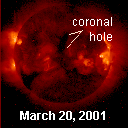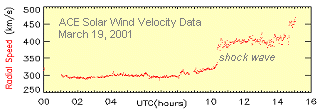|   SPACE WEATHER SPACE WEATHER
Current
Conditions
Solar Wind
velocity: 381.2 km/s
density:1.9 protons/cm3
explanation | more data
Updated: Today at 2148 UT
X-ray Solar Flares
6-hr max: M1 2105 UT Mar20
24-hr: M1 1505 UT Mar20
explanation | more data
Updated: Today at 2245 UT
Daily Sun: 20 Mar '01 
Sunspot group 9373 has a beta-gamma magnetic field that may harbor energy for M-class solar flares.
Sunspot Number: 85
More about sunspots
Updated: 19 Mar 2001
Radio Meteor Rate
24 hr max: 70 per hr
Listen to the Meteor Radar!
Updated: 18 Mar 2001 Interplanetary Mag. Field
Btotal: 18.2 nT
Bz: 8.6 nT south
explanation | more data
Updated: Today at 2148 UT Coronal Holes:

A tiny coronal hole crossing the center of the Sun's disk is spewing a solar wind stream that Earth may encounter later this week. Image credit: Yohkoh Soft X-ray Telescope.
More about coronal holes
 SPACE WEATHER SPACE WEATHER
NOAA
Forecasts
Solar Flares: Probabilities for a medium-sized (M-class) or a major (X-class) solar flare during the next 24/48 hours are tabulated below.
Updated at 2001 Mar 20 2200 UT
| FLARE | 24 hr | 48 hr | | CLASS M | 60 % | 50 % | | CLASS X | 01 % | 01 % |
Geomagnetic Storms: Probabilities for significant disturbances in Earth's magnetic field are given for three activity levels: active, minor storm, severe storm
Updated at 2001 Mar 20 2200 UT Mid-latitudes | 24 hr | 48 hr | | ACTIVE | 25 % | 50 % | | MINOR | 05 % | 10 % | | SEVERE | 01 % | 05 % |
High latitudes | 24 hr | 48 hr | | ACTIVE | 30 % | 60 % | | MINOR | 10 % | 15 % | | SEVERE | 05 % | 05 % |
| What's Up in Space -- 20 Mar 2001
Subscribe to Space Weather News! GEOSTORM: The arrival of a coronal mass ejection on Monday (see below) triggered strong geomagnetic activity that has persisted for nearly 24 hours. A G3-category geomagnetic storm is in progress with no signs of abating. Storm conditions are lingering because the interplanetary magnetic field (IMF) near Earth has developed a strong south-pointing component. South-pointing IMFs create a weak spot in Earth's protective magnetosphere that can allow solar wind gusts to penetrate.  Above: The Planetary K-index, a measure of global geomagnetic activity, reached 7 on March 20th. Sky watchers above geomagnetic latitude ~50 deg. should be alert for auroras. NOAA geomagnetic latitude maps: North America, Eurasia, South Africa & Australia, South America IMPACT! An interplanetary shock wave buffeted Earth's magnetosphere Monday morning at 1100 UT. The disturbance was the leading edge of a coronal mass ejection (CME) that left the Sun on March 15th. [450 kb CME animation]  HERE COMES THE SUN: Coronagraphs on board the ESA-NASA Solar and Heliospheric Observatory spotted a faint full-halo coronal mass ejection (CME) on March 19th at 05:26 UT. The CME emerged just after a solar filament collapsed near the center of the Sun's visible disk. This CME is apparently Earth-directed and could arrive on March 22nd or 23rd. MIR UPDATE: On March 20, 2001, the Russian Space Agency reports that space station Mir is 224.4 km above Earth and losing altitude at a rate of 3.5 km per day. Deorbiting maneuvers are currently slated to begin on March 23nd. [Full Story] WEB LINKS: NOAA FORECAST | GLOSSARY | SPACE WEATHER TUTORIAL | LESSON PLANS | BECOME A SUBSCRIBER | 
Potentially Hazardous Asteroids (PHAs) are space rocks larger than ~100m that can come closer to Earth than 0.05 AU. None of the known PHAs are on a collision course with our planet, although astronomers are searching for and discovering new ones all the time.
On 20 Mar 2001 there were 291 known Potentially
Hazardous Asteroids The most recently discovered near-Earth asteroid is 2001 EC16, a ~150m-wide space rock spotted on March 15th by Eleanor Helin and colleagues using JPL's NEAT/MSSS 1.2-meter survey telescope in Hawaii. 2001 EC16 will pass approximately four lunar distances from Earth on March 23rd. [3D orbit][ephemeris] Other upcoming Earth-asteroid encounters (Mar 1 - Apr 30) | Object | Date (UTC) | Miss Distance | | 2000 PN9 | 2001-Mar-02 17:29 | 0.0610 AU | | 1998 SF36 | 2001-Mar-29 18:37 | 0.0383 AU | | 1986 PA | 2001-Apr-03 01:06 | 0.1465 AU | | 2000 EE104 | 2001-Apr-12 20:37 | 0.0822 AU | 
- TOTAL LUNAR ECLIPSE: On Jan. 9, 2001, the full Moon glided through Earth's copper-colored shadow. [gallery]
- CHRISTMAS ECLIPSE: Sky watchers across North America enjoyed a partial solar eclipse on Christmas Day 2000 [gallery]
- LEONIDS 2000: Observers around the globe enjoyed three predicted episodes of shooting stars. [gallery]
 Feb. 21, 2001: Nature's Tiniest Space Junk -- Using an experimental radar at the Marshall Space Flight Center, scientists are monitoring tiny but hazardous meteoroids that swarm around our planet. Feb. 15, 2001: The Sun Does a Flip -- NASA scientists who monitor the Sun say our star's enormous magnetic field is reversing -- a sure sign that solar maximum is here. Jan. 25, 2001: Earth's Invisible Magnetic Tail -- NASA's IMAGE spacecraft, the first to enjoy a global view of the magnetosphere, spotted a curious plasma tail pointing from Earth toward the Sun. Jan. 4, 2001: Earth at Perihelion -- On January 4, 2001, our planet made its annual closest approach to the Sun. Dec. 29, 2000: Millennium Meteors -- North Americans will have a front-row seat for a brief but powerful meteor shower on January 3, 2001. Dec. 28, 2000: Galileo Looks for Auroras on Ganymede -- NASA's durable Galileo spacecraft flew above the solar system's largest moon this morning in search of extraterrestrial "Northern Lights" Dec. 22, 2000: Watching the Angry Sun -- Solar physicists are enjoying their best-ever look at a Solar Maximum thanks to NOAA and NASA satellites. MORE SPACE WEATHER HEADLINES |



